
Cover Letters
Crafting Your Cover Letter
Introduction
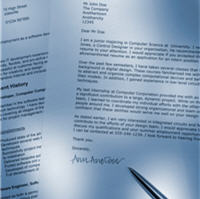 You've found the job you want and have spruced up your resume in hopes of getting it. Now all you have to do is submit it, right? Not so fast!
You've found the job you want and have spruced up your resume in hopes of getting it. Now all you have to do is submit it, right? Not so fast!
Every resume should have a great cover letter to go with it.
So what's a cover letter? And why do you need one?
This lesson will help you answer these questions as you explore interactive examples. Specifically, you will learn the purpose of a cover letter, identify the main parts of a cover letter, find out what makes a cover letter effective, and use several cover letter dos and don'ts as you write your own cover letter.
What is a cover letter?
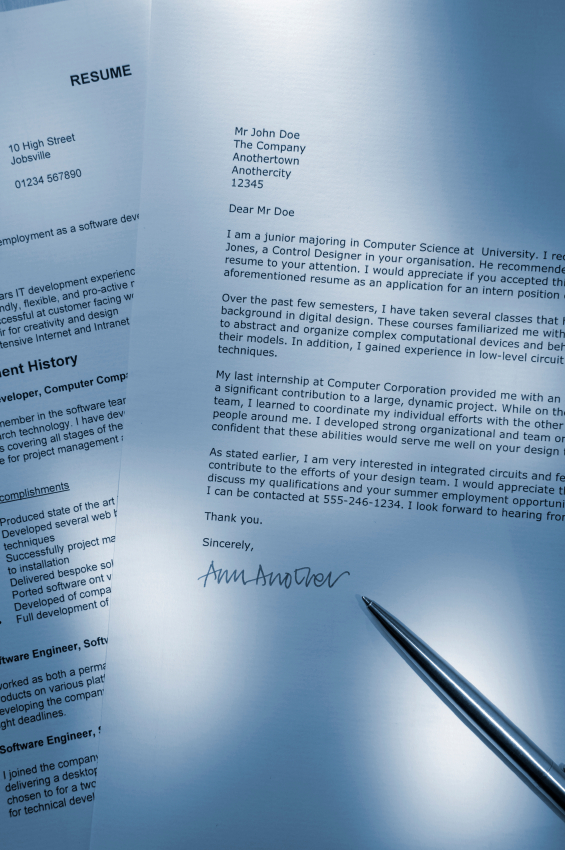 Cover Letter
Cover LetterAs discussed in our Resume Writing tutorial, prospective employers use your resume to learn about your education, skills, and work history, as well as who you are and how to reach you. Your cover letter has a slightly different purpose.
As the name implies, a cover letter is a document that introduces you and accompanies your resume. It is what a hiring manager will see first.
In a competitive job market, hiring managers may get hundreds of resumes for only one position. Going through all of them can be time consuming. To alleviate the time strain, most hiring managers will quickly read over or scan cover letters to decide which resumes to read more closely.
Cover letters provide YOU with an opportunity to:
- Demonstrate how well you express yourself and that you have researched the organization and position
- Tell prospective employers what position you’re interested in, why you are interested in it, and how you came to know about it
- Highlight a few key skills that demonstrate your qualifications for the specific organization and position
- Thank the hiring manager in advance for her time and consideration
Cover letters provide HIRING MANAGERS with a chance to:
- Decide whether to look at your resume
- Select a small number of resumes to read more closely
Both resumes and cover letters should be customized for each specific job opportunity. If you see a job posting that requests a resume, send both a cover letter and resume.
Include a cover letter every time you submit a resume for a job, even if you are emailing it or uploading it to a job board!
What are the parts of a cover letter?
A cover letter is really just a formal business letter that acts as an introduction to your resume. Because it is a formal business document, it should be in block business letter format. In this format, text is left justified (aligned on the left-hand margin).
Review the interactive below to learn the about the standard block format cover letter and the purpose of each part.
Writing an effective cover letter
To be effective, the body paragraphs of your cover letter must really sell you as the best candidate for the job. This area should highlight your accomplishments and qualifications, as well as explain how you can benefit the company. It should be easy to read and have a positive tone.
Each paragraph of your cover letter has a different purpose, and there are strategies you can use to make each paragraph effective.
Use the interactive below to look at the three body paragraphs in Samantha's cover letter to see what she did, and what you can do in your own cover letter, to make each more effective.
Cover letter tips
The following are some tips to make your cover letter the best it can be.
Gather all necessary information first.
This includes the job description, name of the hiring manager, and any other research you have gathered about the company.
Follow directions.
Some employers may want you to provide additional materials, such as writing samples, with your resume. Others might not accept applications that are sent via email. Before you respond to any job posting, read the directions carefully so you can provide exactly what is required.
Address your letter to a specific individual.
If this is not possible, use a gender-neutral greeting, like Dear Hiring Manager or Staff Selection Team.
Write a rough draft.
Focus on the purpose of each paragraph:
- In the first paragraph, introduce yourself, indicate the desired position, and explain how you came to know about the position.
- In the second paragraph, sell yourself as the ideal candidate by matching your experience with employer needs.
- In the final paragraph, request action on the part of the employer or explain what actions you will be taking to progress in the job search process.
Use good writing techniques.
Characteristics of good writing for cover letters include:
- Using bullet points or bold text to highlight your qualifications
- Using concise and clear language; keep it to one page and focus on what you have to offer an employer
- Using correct grammar; have at least two strong writers edit and proofread your cover letter, and do not rely solely on a spell checker
- Using active verbs in the present tense to illustrate your skills; for example, I consistently exceed customer expectations by offering personal attention and product expertise.
- Varying your word choice; for example, if your specialty is product line management, try to find another phrase for the same function, such as family branding
Format your cover letter to be easy to read.
This should be done only after you are completely satisfied with the content of your rough draft.
- Use default margins (1.25” for the right and left margins, 1” for the bottom margin).
- Single-space paragraphs.
- Double-space after the date, each address, the greeting, and each paragraph.
- Leave enough space for your signature.
- Use bold for emphasis and quick reading. Hiring managers will be skimming the letter, so anything you can do to make your qualifications stand out will help focus their attention on you.
- Use a default font that is easy to read, such as Times New Roman, Arial, or Tahoma.
Note: Our Microsoft Office tutorials cover formatting in more depth.
Consider using resume paper.
If you want to make your application look extra nice, you can print your cover letter and resume on resume paper. Resume paper is sometimes also known as business or specialty paper, and it is thicker and rougher than regular printer paper. However, it's also more expensive, so you may not want to use it for every job application.
Mistakes to avoid
There are several things job seekers can do in their cover letters that can actually hurt their chances of getting an interview. You will want to avoid these mistakes.
- Don’t write “To Whom It May Concern” or "Dear Sir or Madam". If you don't know the person's name, use something generic and gender neutral, like Candidate Selection Team or Dear Hiring Manager.
- Don’t use slang, like I crushed the highest sales in my region three years running.
- Don’t use correction fluid or make corrections after a letter is printed. Reprint your letter if necessary.
- Don’t write a letter that's longer than one page.
- Don’t provide false information about yourself or your qualifications.
- Don't include erroneous information about a company.
- Don’t include personal information (avoid references to religion, family, etc.).
- Don’t write poorly (avoid using cliches, exaggeration, and typographical or grammatical errors).
- Don’t use form letters and mass mailings. Each letter should be tailored to a specific job.
- Don’t include photos unless it's specifically requested.
- Don’t confess weakness or apologize for lacking a qualification.
- Don’t use an improper tone (angry, demanding, desperate, confessional, or too enthusiastic).
- Don’t include salary information unless it's requested.
You try it!
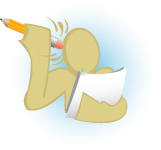
Open the Microsoft Word Cover Letter Template and Save it to your computer with a name that makes sense to you.
Enter your own information into the document as you progress through this activity by replacing the text inside the [brackets]. Remove the brackets as well.
The top of your cover letter
Refer to the picture below as you make changes to the top portion of your cover letter.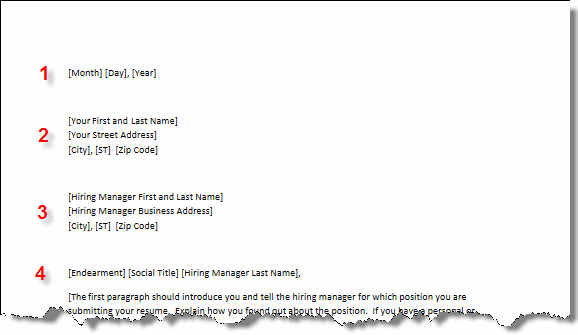
- Enter the Date as Month date, year: January 27, 2009, for example.
- Enter your own return address information:
- Replace [Your First and Last Name] with your own name. For example, type Jodi Hartfield.
- Replace [Your Street Address] and [City], [ST] [Zip Code] with the address where you live and receive mail. For example, type:
123 Long Lake Boulevard
Raleigh, N.C. 27601
- Enter the name and business address of the person to whom you are submitting your resume:
- Replace [Hiring Manager First and Last Name], [Hiring Manager Business Address], [City], [ST] and [Zip Code] with the appropriate information.
If you do not have a contact name, you can omit this section or include a line that indicates what the letter is in response to, such as RE: Office Manager postion (Craigslist posting CR-01004-OM). This can help the person handling the mail pass your cover letter and resume on to the correct person within the company.
- Replace [Hiring Manager First and Last Name], [Hiring Manager Business Address], [City], [ST] and [Zip Code] with the appropriate information.
- Replace [Endearment] [Social Title] [Hiring Manager Last Name], with an appropriate greeting, such as Dear Mr. Grantham or Ms. Keaton. Use social titles (e.g., Mr. or Ms.) ONLY when you know for certain an individual's gender.
If you do not have a contact name, you can use something generic and non-gender specific such as Dear Staff Selection Team or Dear Hiring Manager. However, resume experts recommend trying to find the name of the person who will be hiring for the position.
The body of the cover letter
Refer to the picture below as you make changes to the body of your cover letter.
- Write your first body paragraph, replacing the text within the brackets with your own text that addresses the following:
- Include your name and the position (job name and number) in which you are interested.
- Explain how you came to know about the position.
- Make a personal or business connection to the company, if you can, or show what you know about the company.
- Write your second body paragraph, replacing the text within the brackets with your own text that addresses the following:
- Point out your accomplishments and qualifications that make you the best choice for the job.
- Focus on what benefits you will bring to the position or company. Think of it as what you can do for them.
- You may want to use bold text or a bulleted list to emphasize your strong points.
- Write your third body paragraph, replacing the text within the brackets with your own text that addresses the following:
- Tell them what you would like to have happen next. For example, I look forward to discussing how my expertise in customer service can benefit ABC Company. If I do not hear from you by March 3, I will be contacting you to ensure you have received and reviewed my resume.
- Don't forget to include a way for someone to contact you. For example, You can reach me at the phone number below after 4 p.m. daily if you have any questions or would like to further discuss my qualifications.
- Remember to thank the hiring manage for his or her time and consideration!
The bottom of the cover letter
Refer to the picture below as you make changes to the bottom portion of your cover letter.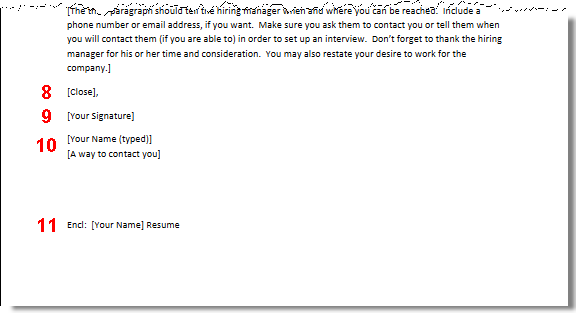
- Replace [Close], with a polite and professional closing, such as Regards,.
- Hit enter several times to leave enough space for your signature, then delete [Your Signature]. When you have printed the final copy of your cover letter, be sure to sign your name neatly in this area.
- Replace [Your Name (typed)] with your full first and last name. Then, replace [A way to contact you] with either a telephone number or an email address, whichever you prefer as a means of communication.
- On the enclosure line, enter your own name (or the file name if you are submitting your resume electronically) in place of [Your Name].
Don't forget to have several people review your cover letter before you send it out!
Need More Help? Go to our Microsoft Office tutorials cover how to format a document in more depth.
Resources
Online
- PODCAST: Katherine Mehr speaks with Sue Morem, Founder of Go For the Edge!, about how to create an effective cover letter.
- Karen Hansen discusses Resume, Cover Letter, and Interview Strategies for Older Workers at Quinessential Careers.
- Perdue University's Online Writing Lab offers a Resume Workshop page.
Offline
- Knock 'Em Dead Cover Letters: Techniques and Samples for Every Step of Your Job Search by Martin Yate